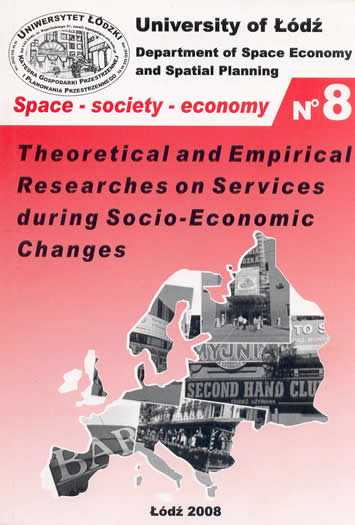Interpreting the spatial preferences of retail firms in the post-1980 period: case of Izmir, Turkey
DOI:
https://doi.org/10.18778/1733-310.08.05Abstract
The year 1980, which is accepted as a significant breaking point in Turkey in terms of the accumulation process of capital, is also an important milestone in the development of retail trade sector in the country. In parallel to the decisions taken in January 24, 1980, model of import substitution for industrialisation has been quitted and a new economic policy has been adopted, priorities and policies of which are directed towards enabling the operability of free market forces. This new structuring in economy has caused radical transformations and changes in trade sector and also in the organisation and spatial distribution of wholesale and retail trade in urban areas. The changes in shopping patterns in parallel to technological improvements, income per capita, car ownership, consumer spending and the increase in the use of credit cards have caused not only the structural change of retail sector but also the diversification of its spatial distribution. The emerging retail types in the form of hypermarkets and large-scaled shopping centres that evolved in accordance with the growth strategies of global and local capital have been accepted as a key indicator of urban identity and become a significant component of urban morphology. The most affected group by this continuing transformation process in retail structure has undoubtedly been the small-scaled, independent, single location, low-capital, mostly family run firms that dominated the retail trade sector since the proclamation of the Republic. This paper seeks to interpret the spatial preferences of retail firms in the post-1980 period in Izmir, as being the third largest city of Turkey, with reference to research findings and economic-political context in global as well as in national scales. Beginning from the 1990s, investments made in the city have tended towards retail and service sectors and inevitably caused a significant effect on the growth dynamics of the city. New consumption spaces, which were established in several axes of the city with the initiatives of the global and local capital, have created new, alternative shopping districts that compete with the traditional town centre.
Downloads
References
Bal, E., Dalgakiran, A. (2007), Presentation of consumption based spaces in a post-modern spatial restructuring within the process of globalisation: case of Forum Bornova-Izmir, in Gur, S.O. (ed.), LIVENARCH III Proceedings Volume I, Contextualism in Architecture, 5–7 July 2007 Trabzon, Turkey, pp. 319–327.
Google Scholar
Dalgakiran, A. (2005), Izmir’de Perakende Ticaret Sektorunun Mekansal Hareketliligi ve Gelecegi Uzerine Stratejiler (Spatial Mobility of the Retail Trade Sector in Izmir and Strategies for the Future), unpublished Ph.D. Thesis prepared in Dokuz Eylul University Graduate School of Natural and Applied Sciences, Izmir, Turkey.
Google Scholar
Osmay, S. (1998), 1923’ten Bugune kent merkezlerinin donusumu (Transformation of city centres since 1923 up to present), in Sey, Y. (ed.), 75 Yilda Degisen Kent ve Mimarlik, Istanbul: Tarih Vakfi Yayinlari.
Google Scholar
Ozdemir, D. (2000), Yabancı sermayenin Istanbul haritası (Istanbul map of foreign capital), Istanbul, 35: 96–104.
Google Scholar
Sengül, T. (2002), Tuketim toplumu, tuketim kulturu ve tuketim merkezleri, (Consumption society, consumption culture and the spaces of consumption). Egemimarlık, 40–41: 8–9.
Google Scholar
Tokatli, N. and Boyaci, Y. (1998), The changing retail industry and retail landscapes, Cities, 15: 345–359.
Google Scholar
DOI: https://doi.org/10.1016/S0264-2751(98)00030-4
Downloads
Published
How to Cite
Issue
Section
License

This work is licensed under a Creative Commons Attribution-NonCommercial-NoDerivatives 3.0 Unported License.









